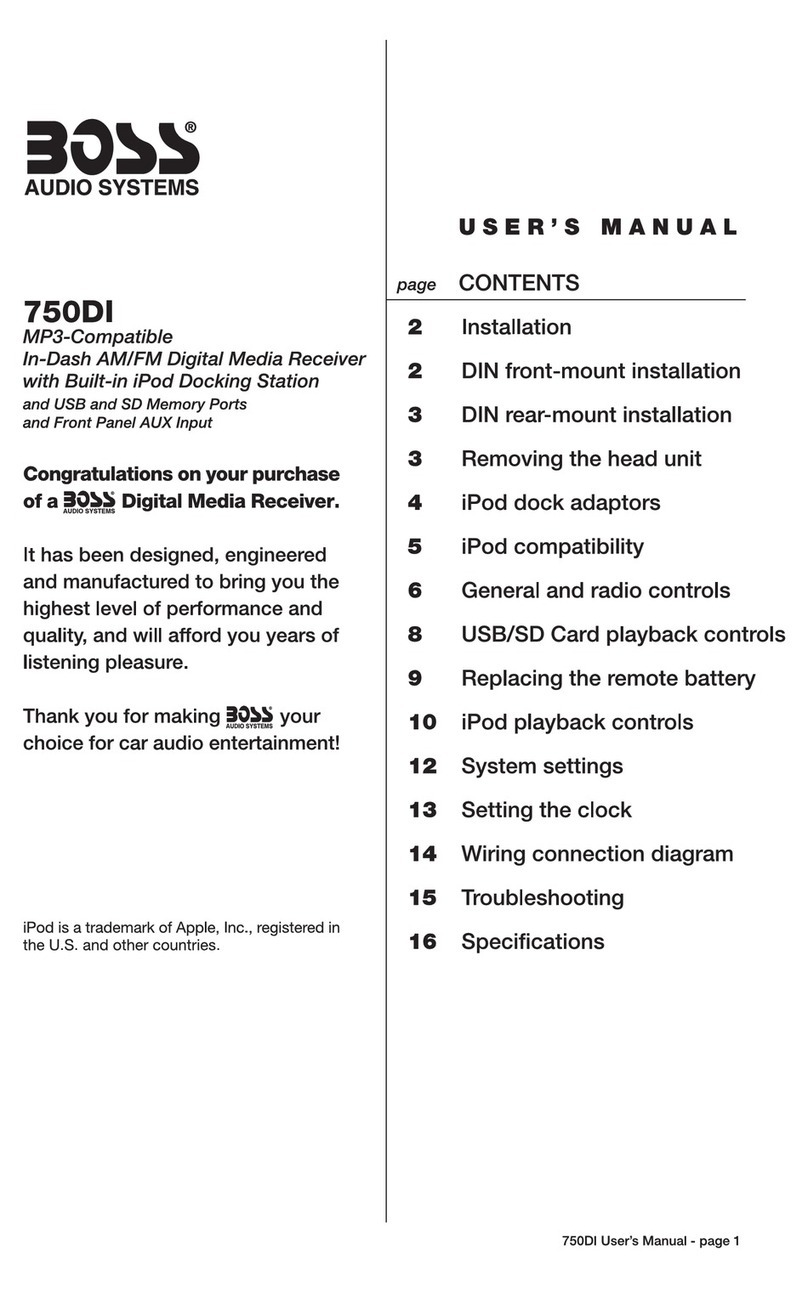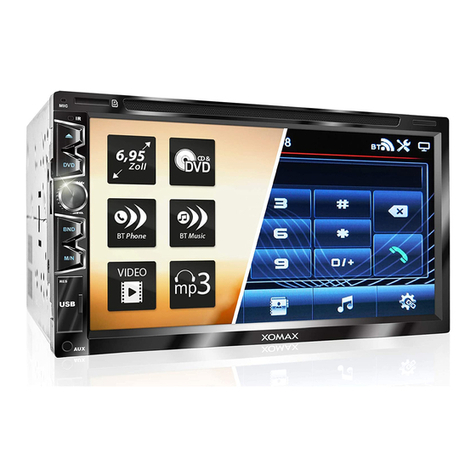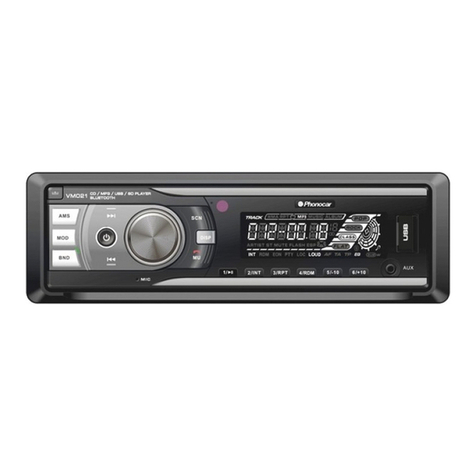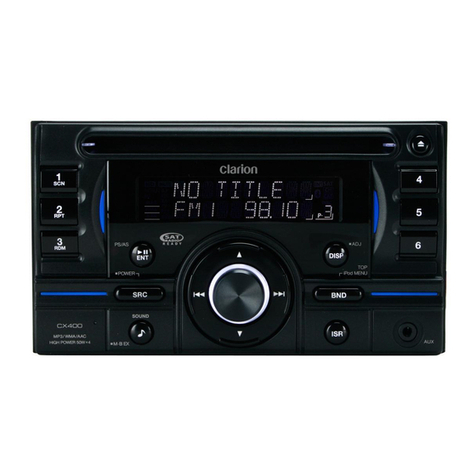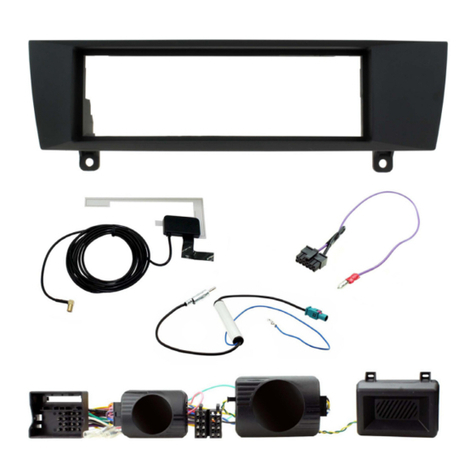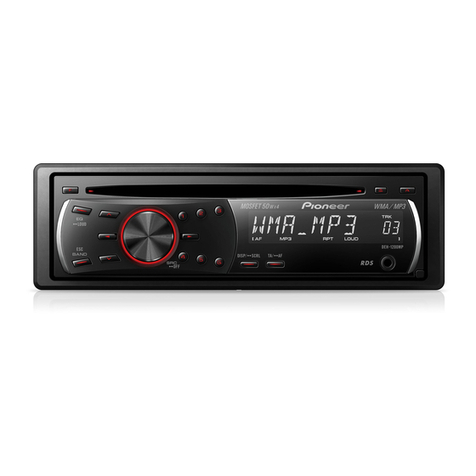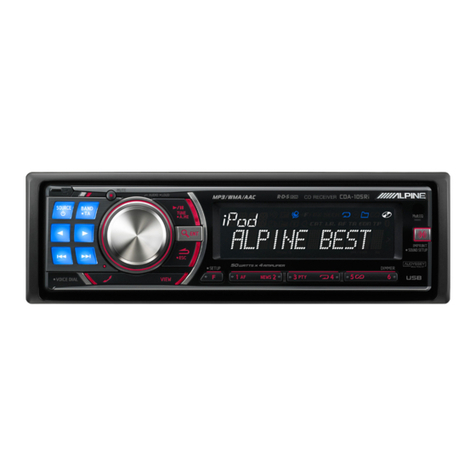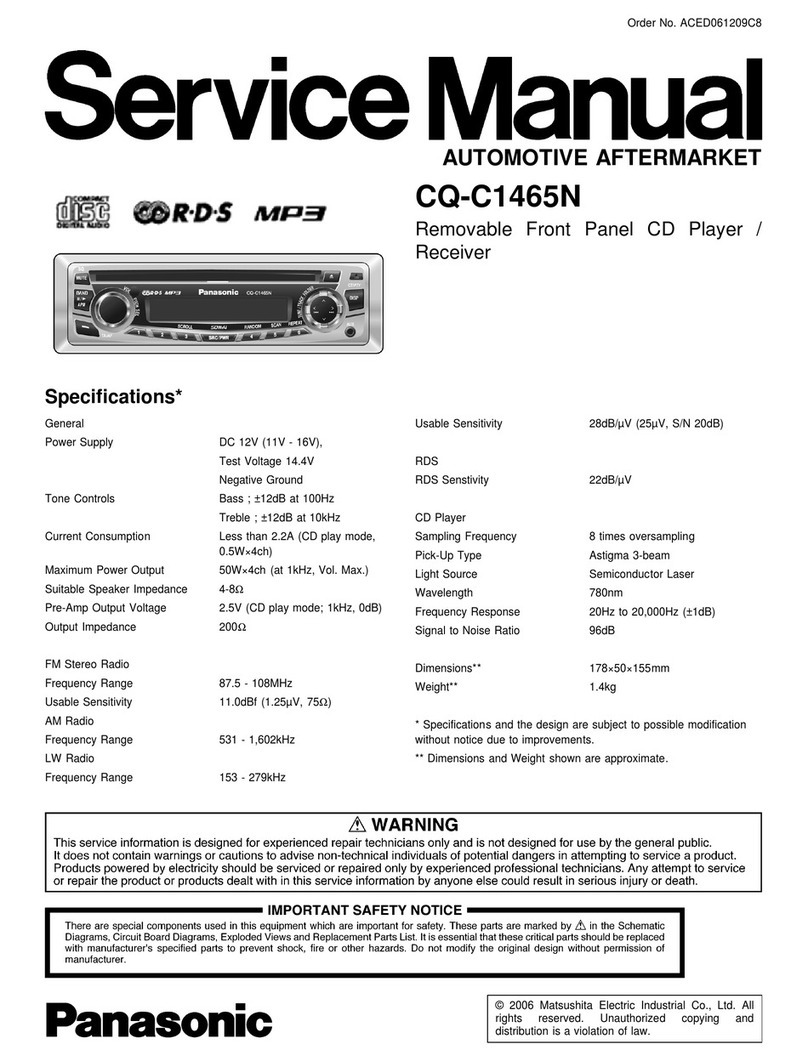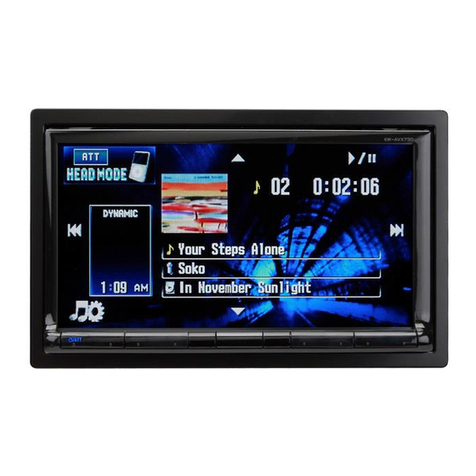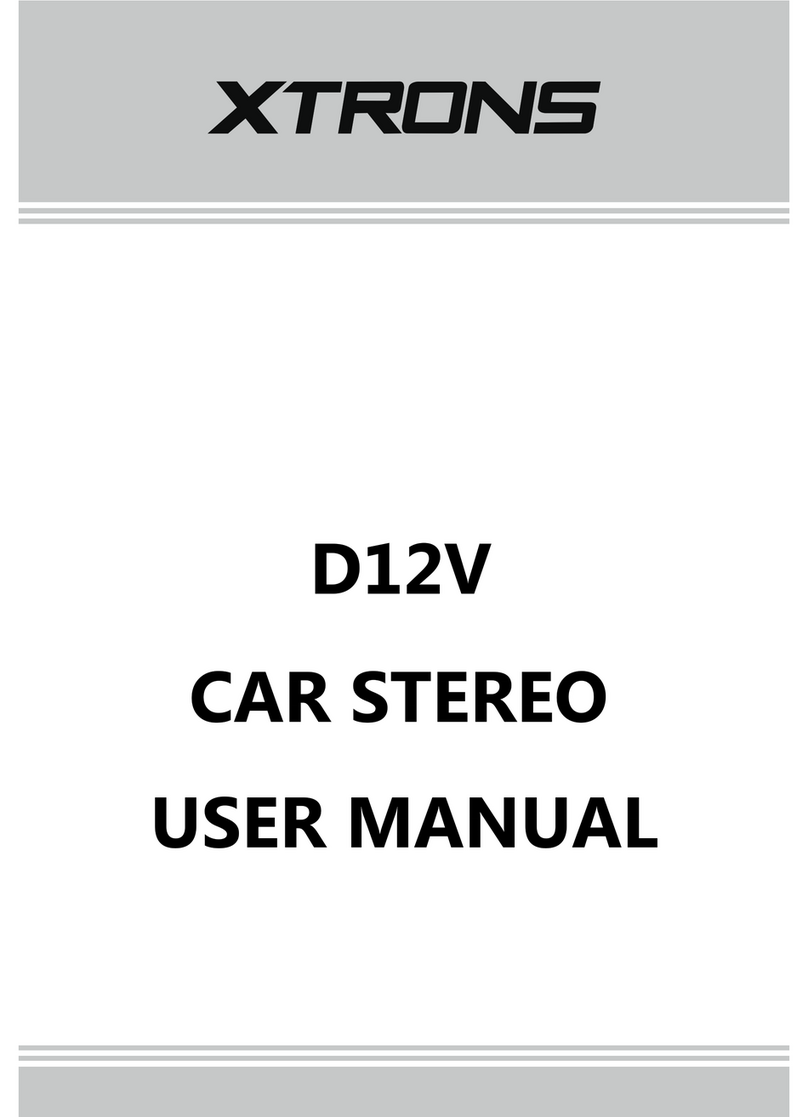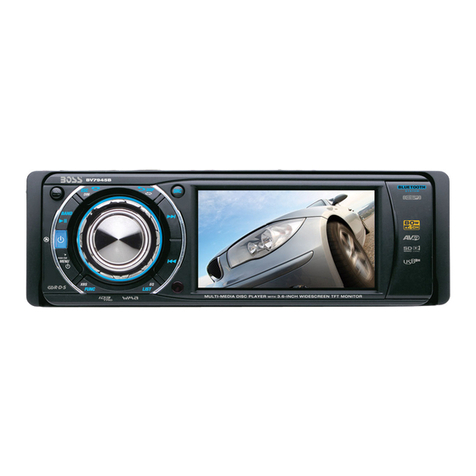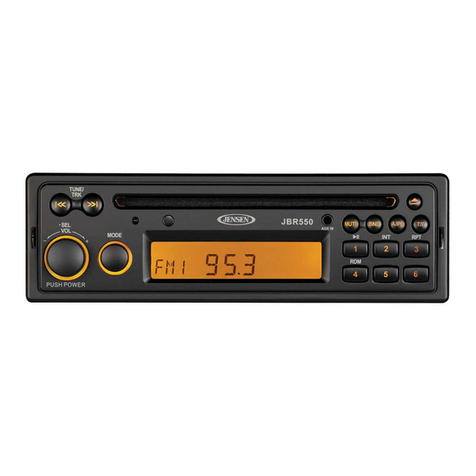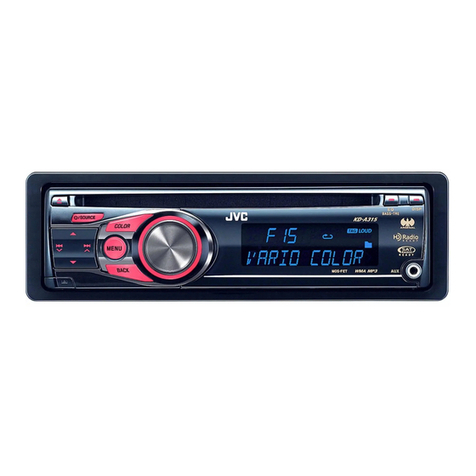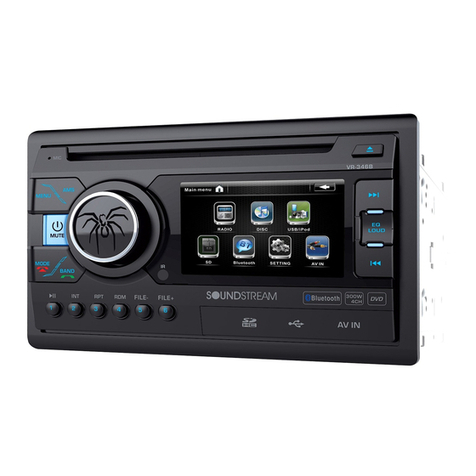CCS CR017 Classic 200 User manual

DAB DAB+ FM RDS USB
Bluetooth hands free & streaming
Aux in radio
Part no. CR017 Classic 200
Please read this manual before use
(Version 2)

3
Audio Source selection
Contents
Audio Source selection 3
DAB / DAB+ 4-5
FM Radio 5
Bluetooth music streaming 6
Bluetooth hands free mobile phone 7
Auxiliary input 7
USB 7
IPod mode 8
Installation 8-11
Mounting the radio 11
Diagnostics 12-13
Wiring diagram 14
Dimensioned drawing 14
Electrical connections 15
2
Contents
Audio Source selection 3
DAB / DAB+ 4-5
FM Radio 5
Bluetooth music streaming 6
Bluetooth hands free mobile phone 7
Auxiliary input 7
USB 7
IPod mode 8
Installation 8-11
Mounting the radio 11
Diagnostics 12-13
Wiring diagram 14
Dimensioned drawing 14
Electrical connections 15
2
Audio Source selecon 4
DAB / DAB+ 5
FM Radio 5-6
Bluetooth music streaming 6
Bluetooth hands free mobile phone 7
Auxiliary input 7
USB 7
Installaon 8-9
Mounng the radio 10
Diagnoscs 11-12
Dimensioned drawing 13
Electrical connecons 14

DAB / DAB+
4
Please note the clock is only displayed for 5 seconds aer pressing buon number 1.
To select the mode, press buon number 7 to scroll between dab/fm/bt music (USB
or I Pod if connected) and auxiliary input.
Dab /DAB +radio operaon
To tune in the dab radio press buon number 6, the display will show full scan then
press and hold buon number 6 for 2 seconds to start the staon search. The display
will show scanning and a progress bar and the number of staons found will be
indicated on the top right of the display. Alternavely you can press and hold buon
7 to scan.
The radio will then store all the staons that have been found in alphabecal order
and begin playing the rst staon in that order.
To select a specic staon, turn buon number 7 unl the relevant staon name is
displayed. The display will show connecng and will begin to play the staon. If you
are out of the staon recepon area or if the signal is too weak, the display will show
“service not available”. Alternavely you can turn and hold buon number 7 to scroll
through the staons faster either clockwise to scroll forwards or an clockwise to
scroll backwards. Releasing the buon stops the scrolling.
You can pre set up to four staons by rstly selecng the staon then press and hold
the pre set buons numbers 2, 3, 4 or 5 for 2 seconds. The display will show “preset
a stored”. The pre sets can be over wrien at any me by repeang the procedure.
To manually tune the radio press buon number 6 then turn buon number 7 to
show manual tune, then press buon 6 for 2 seconds, turning buon number 7 will
now manually tune showing the staon frequency.
To select the DRC (Dynamic Range Compression) funcon, press buon number 6
then turn buon number 7 to show DRC in the display. Press buon number 6 for
2 seconds then turn buon number 7 to scroll between o, low and high. Press and
hold buon 6 to store the selected level.
Dynamic Range Compression; this feature can make it easier to hear quieter sounds
whilst in a noisy environment. The DRC funcon will increase the volume of quieter
parts and decrease the volume of the louder parts of a radio broadcast. Please note
that not all DAB broadcasts support the DRC funcon.
Prune, this feature allows you to remove any DAB staons from the memory that can
no longer be received either due to frequency changes or being out of the staon/
recepon area. To select this funcon press buon number 6 then turn buon
number 7 unl Prune is shown in the display, press and hold buon 6 for 2 seconds
3
Audio Source selection
3
Audio Source selection
3
Audio Source selection

5
FM Radio
DAB / DAB+
4
Please note the clock is only displayed for 5 seconds aer pressing buon number 1.
To select the mode, press buon number 7 to scroll between dab/fm/bt music (USB
or I Pod if connected) and auxiliary input.
Dab /DAB +radio operaon
To tune in the dab radio press buon number 6, the display will show full scan then
press and hold buon number 6 for 2 seconds to start the staon search. The display
will show scanning and a progress bar and the number of staons found will be
indicated on the top right of the display. Alternavely you can press and hold buon
7 to scan.
The radio will then store all the staons that have been found in alphabecal order
and begin playing the rst staon in that order.
To select a specic staon, turn buon number 7 unl the relevant staon name is
displayed. The display will show connecng and will begin to play the staon. If you
are out of the staon recepon area or if the signal is too weak, the display will show
“service not available”. Alternavely you can turn and hold buon number 7 to scroll
through the staons faster either clockwise to scroll forwards or an clockwise to
scroll backwards. Releasing the buon stops the scrolling.
You can pre set up to four staons by rstly selecng the staon then press and hold
the pre set buons numbers 2, 3, 4 or 5 for 2 seconds. The display will show “preset
a stored”. The pre sets can be over wrien at any me by repeang the procedure.
To manually tune the radio press buon number 6 then turn buon number 7 to
show manual tune, then press buon 6 for 2 seconds, turning buon number 7 will
now manually tune showing the staon frequency.
To select the DRC (Dynamic Range Compression) funcon, press buon number 6
then turn buon number 7 to show DRC in the display. Press buon number 6 for
2 seconds then turn buon number 7 to scroll between o, low and high. Press and
hold buon 6 to store the selected level.
Dynamic Range Compression; this feature can make it easier to hear quieter sounds
whilst in a noisy environment. The DRC funcon will increase the volume of quieter
parts and decrease the volume of the louder parts of a radio broadcast. Please note
that not all DAB broadcasts support the DRC funcon.
Prune, this feature allows you to remove any DAB staons from the memory that can
no longer be received either due to frequency changes or being out of the staon/
recepon area. To select this funcon press buon number 6 then turn buon
number 7 unl Prune is shown in the display, press and hold buon 6 for 2 seconds
Please note the clock is only displayed for 5 seconds aer pressing buon number 1.
To select the mode, press buon number 7 to scroll between dab/fm/bt music (USB
if connected) and auxiliary input.
DAB /DAB +radio operaon
To tune in the dab radio press buon number 6, the display will show full scan then
press and hold buon number 6 for 2 seconds to start the staon search. The display
will show scanning and the number of staons found will be indicated on the top
right of the display. Alternavely you can press and hold buon 7 to scan.
The radio will then store all the staons that have been found in alphabecal order
and begin playing the rst staon in that order.
To select a specic staon, turn buon number 7 either le or right repeatedly unl
the relevant staon name is displayed. The display will show “playing” and will begin
to play the staon. If you are out of the staon recepon area or if the signal is too
weak, the display will show “service not available”.
You can pre set up to four staons by rstly selecng the staon then press and hold
the pre set buons numbers 2, 3, 4 or 5 for 2 seconds. The display will show “stored”.
The pre sets can be over wrien at any me by repeang the procedure.
System, to perform a factory reset, select DAB then press buon 6 briey and then
turn buon 7 unl the display shows <system>. Press and hold buon 6 for 2 seconds,
display shows <factory Reset>, press and hold buon 6 again. The unit will revert
back to factory sengs and clear any sengs and radio staons that have previously
been stored in the memory.
To exit from any of the sengs selected press buon number 6 briey or wait for 10
seconds.
FM radio
To tune in the FM radio select the FM mode, the display will show 87.5MHz (no
radio Text). Press and hold buon 7 thn the display will show “scanning” and will
automacally set up to 18 preset staons into the memory.
To select any of the presets, turn buon 7 to scroll through 1 to 18 or you can press
buons 2, 3, 4, 5, or 6 to select the rst 5 presets. Please note, the radio may not
necessarily nd 18 staons depending on the recepon area.
You can then set any of the FM staons to preset buons 2, 3, 4, 5 and 6 by turning
buon 7 to select the required staon, then press and hold the relevant preset
buon, the display will show that the staon has been set by displaying “stored”. This
will not alter any DAB staons that you may have previously stored.
DAB / DAB+
4
Please note the clock is only displayed for 5 seconds aer pressing buon number 1.
To select the mode, press buon number 7 to scroll between dab/fm/bt music (USB
or I Pod if connected) and auxiliary input.
Dab /DAB +radio operaon
To tune in the dab radio press buon number 6, the display will show full scan then
press and hold buon number 6 for 2 seconds to start the staon search. The display
will show scanning and a progress bar and the number of staons found will be
indicated on the top right of the display. Alternavely you can press and hold buon
7 to scan.
The radio will then store all the staons that have been found in alphabecal order
and begin playing the rst staon in that order.
To select a specic staon, turn buon number 7 unl the relevant staon name is
displayed. The display will show connecng and will begin to play the staon. If you
are out of the staon recepon area or if the signal is too weak, the display will show
“service not available”. Alternavely you can turn and hold buon number 7 to scroll
through the staons faster either clockwise to scroll forwards or an clockwise to
scroll backwards. Releasing the buon stops the scrolling.
You can pre set up to four staons by rstly selecng the staon then press and hold
the pre set buons numbers 2, 3, 4 or 5 for 2 seconds. The display will show “preset
a stored”. The pre sets can be over wrien at any me by repeang the procedure.
To manually tune the radio press buon number 6 then turn buon number 7 to
show manual tune, then press buon 6 for 2 seconds, turning buon number 7 will
now manually tune showing the staon frequency.
To select the DRC (Dynamic Range Compression) funcon, press buon number 6
then turn buon number 7 to show DRC in the display. Press buon number 6 for
2 seconds then turn buon number 7 to scroll between o, low and high. Press and
hold buon 6 to store the selected level.
Dynamic Range Compression; this feature can make it easier to hear quieter sounds
whilst in a noisy environment. The DRC funcon will increase the volume of quieter
parts and decrease the volume of the louder parts of a radio broadcast. Please note
that not all DAB broadcasts support the DRC funcon.
Prune, this feature allows you to remove any DAB staons from the memory that can
no longer be received either due to frequency changes or being out of the staon/
recepon area. To select this funcon press buon number 6 then turn buon
number 7 unl Prune is shown in the display, press and hold buon 6 for 2 seconds

Bluetooth music streaming
6
Two seconds aer releasing buon 7, the display will show “auto” and revert back to
pre set selecon mode.
If the staon that you are listening to supports radio text, the transmied informaon
will scroll across the display at the boom whilst showing the staon name and pre
set number across the top. If there is no radio text available or a weak signal, then
the display will show “no Radio Text”
The FM scan can be performed at any me but please note that any previously stored
staons will be replaced with those found during the new scan.
Stereo/mono, If you are listening to a weak FM staon you can switch the tuner to
Mono which may help eliminate any unwanted background noise/interference. Press
buon number 6 briey then turn buon 7 unl the display shows Audio Seng
then hold buon 6 for 2 seconds, you can then turn buon 7 to scroll between
“Stereo allowed “ and “Forced Mono”. Select “Forced mono” Stereo allowed” then
hold buon 6 for 2 seconds.
Bluetooth
The Classic 200 can play music from a Bluetooth music device or mobile phone.
Firstly you should pair the device in queson by turning on Bluetooth in its menu and
searching for the Classic 200. You should then select the device named Autosound
and connect to it. If your device requests a pin number, enter 0000.
Each me you turn on the Classic 200, your device should connect automacally,
however, you should make sure that your device is set for automac connecon of
Bluetooth devices.
The “BT” symbol will ash on the display unl the device is connected then it will
become stac indicang there is a Bluetooth link. “BT” is not shown in DAB/FM
mode. Depending on your device, the radio display may show “BT Talk” and mute
the sound momentarily each me it connects.
You can now play your music via Bluetooth by selecng BT Music in the menu.
Turning buon 7 anclockwise will select the previous track and turning clockwise
will select the next track.
Pressing buon number 2 will pause the music and pressing it again will resume play.
If your Bluetooth device is also a mobile phone, pressing buon 3 will dial the last
number, pressing again ends the call.
5
FM Radio
Manual tune, to manually tune an FM staon, turn and hold buon number 7 unl
the display shows “Manual” then release, now turning buon 7 will manually tune
up or down accordingly.
Two seconds aer releasing buon 7, the display will show “auto” and revert back to
pre set selecon mode.
If the staon that you are listening to supports radio text, the transmied informaon
will scroll across the display at the boom whilst showing the staon name and pre
set number across the top. If there is no radio text available or a weak signal, then the
display will show “no Radio Text”
The FM scan can be performed at any me but please note that any previously stored
staons will be replaced with those found during the new scan.
Bluetooth
The Classic 200 can play music from a Bluetooth music device or mobile phone.
Firstly you should pair the device in queson by turning on Bluetooth in its menu and
searching for the Classic 200. You should then select the device named Autosound
and connect to it. If your device requests a pin number, enter 0000.
Each me you turn on the Classic 200, your device should connect automacally,
however, you should make sure that your device is set for automac connecon of
Bluetooth devices.
The “BT” symbol will ash on the display unl the device is connected then it will
become stac indicang there is a Bluetooth link. “BT” is not shown in DAB/FM mode.
Depending on your device, the radio display may show “BT Talk” and mute the sound
momentarily each me it connects.
You can now play your music via Bluetooth by selecng BT Music.
Turning buon 7 anclockwise will select the previous track and turning clockwise
will select the next track.
Pressing buon number 2 will pause the music and pressing it again will resume play.
If your Bluetooth device is also a mobile phone, pressing buon 3 will dial the last
number, pressing again ends the call.
Bluetooth

7
Bluetooth hands free mobile phone
7
Bluetooth hands free mobile phone
Mobile phone operaon
To answer an incoming call press buon number 3.
To end or reject a call press buon number 2.
There is no opon to select and dial other numbers from the Classic 200, this can
only be done from your telephone handset.
The hands free volume can be adjusted by turning buon number 1 during a
telephone call. This will not aect the volume of the audio source that has been
interrupted by the call.
Auxiliary unput
You can play music from a portable music device that has a headphone jack output.
Connect the device using a suitable cable to the red and white phono y lead at the
rear of the Classic 200 marked “Aux Input”.
Select the aux in mode by pressing buon number 7. You may need to increase or
decrease the volume on your music device to achieve a volume equal to that of the
radio etc.
USB mode
You can play music from a USB sck by connecng it to the y lead at the rear of the
unit marked USB.
The device will automacally recognise the USB and begin playing the music. The
display will scroll between the track number / the total number of tracks / elapsed
me of the track that is currently playing and the song tle / arst / album tle
providing this informaon is available from the USB.
Next/previous track To select the next track, turn buon 7 clockwise and an
clockwise to select the previous track.
To fast forward or fast rewind into a track, turn and hold buon number 7 clockwise
for forward and an clockwise for backwards. Releasing the buon will resume play
at that point.
Pause Press buon number 2 to pause and again to resume play.
Intro Scan Press buon 3, the display will show “INT” then you will hear 10 seconds
of each track. Press buon 3 to resume normal operaon.
Repeat Tracks Press buon 4, the display shows “RPT”. The track will be repeated
unl buon 4 is pressed again.
Random play Press buon 5, the display will show “RDM” and the tracks will now
play in random order, press buon 5 again to resume normal play.
Folder Selecon Press buon 6 to select folders. This will only work if the tracks
have been stored in folders.

I Pod mode
8
Intro scan, press buon number 3 for intro scan, this will play the rst 10 seconds of
each track unl you press it again. The display will show INT in the display to show
that this funcon has been selected.
Repeat, Pressing buon number 4 will turn on the Repeat funcon. This will repeat
the track unl pressed again and will show RPT in the display to indicate that this
funcon has been selected.
Random, This funcon can be selected by pressing buon number 5 and the tracks
will be played in random order unl the buon is pressed again. The display will show
RDM to indicate that this funcon has been selected.
Selecng folder, Pressing buon number 6 will show the folder number in the boom
of the display, to change the folder press again to scroll through the folder numbers.
Please note that some mobile phones / mp3 players may not be compable with the
USB and therefore should be connected via the aux input.
I Pod mode
Connect your I Pod into the y lead marked USB, the Classic 200 will show I Pod in
the display.
Pause/play Pressing buon 2 will pause the music and pressing again will resume
play.
Next and previous track. To select the next track, turn buon number 7 clockwise
and to select the previous track, turn an clockwise.
There is no opon to select folders or albums in I Pod mode. We suggest that you set
a playlist if required.
We recommend that you connect and disconnect your I Pod whilst the Classic 200 is
powered o.
Installaon
Before installing you Classic 200 please make sure that the radio will t into the
aperture provided by the vehicle manufacturer. If there is no radio aperture, we can
supply our underdash tray that allows you to mount the radio below the dashboard/
inside the glovebox. Also, make sure that the vehicle is negave earth, if not our
posive earth adaptor part number CA002 will be required.
The spindles are set at a distance of 132 mm apart, however, they can be adjusted if
necessary to align with pre cut holes in certain dashboards. To do this, remove the
knobs, fascia and spindle nuts on the end of the spindle shas. Next, slacken o the
spindle nuts that secure the shas to the radio body then carefully slide the spindles
Installation
10
ISO Connector B
Purple B1 Right rear speaker posive
Purple/black B2 Right rear speaker negave
Grey B3 Right front speaker posive
Grey/black B4 Right front speaker negave
White B5 Le front speaker posive
White/black B6 Le front speaker negave
Green B7 Le rear speaker posive
Green/black B8 Le rear speaker negave
If you have only two speakers then the un used speaker wires must be insulated and
not connected. It does not maer whether you use the front or the rear speaker
wires.
Any speakers that share a common connecon/earth must be re wired separately
otherwise damage may occur to the radio.
The radio is designed to operate either two or four speakers or one of our DVC (dual
Voice Coil) speakers. It should not be connected to a single speaker on one channel.
The red accessory wire A7 may be connected to a permanent power supply along
with the yellow A4 if there is no accessory posion on your vehicle.
The accessory connecon ( red wire pin no A7) on your Classic 200 is protected with
a 10 amp fuse located the rear case next to the wiring connector. We recommend
ng a separate 5 amp fuse in the permanent power supply ( yellow wire pin no A4).
If the power supply to your Classic 200 is disconnected then any sengs and radio
staons that you have programmed will be retained.
Sub Woofer connecon
The sub woofer line output connecon is a green phono connector on a y lead at
the rear of the radio and will provide a line out signal for an oponal sub woofer/
amplier. The volume of the sub woofer can then be adjusted in the audio sengs.
(-10 to + 10) The sub woofer volume is not aected by the “ fader” seng
Hands free microphone
The hands free microphone should be mounted in front of the driver either at the
top or boom of the windscreen pillar or on the dashboard in a convenient locaon.
I Pod mode
8
Intro scan, press buon number 3 for intro scan, this will play the rst 10 seconds of
each track unl you press it again. The display will show INT in the display to show
that this funcon has been selected.
Repeat, Pressing buon number 4 will turn on the Repeat funcon. This will repeat
the track unl pressed again and will show RPT in the display to indicate that this
funcon has been selected.
Random, This funcon can be selected by pressing buon number 5 and the tracks
will be played in random order unl the buon is pressed again. The display will show
RDM to indicate that this funcon has been selected.
Selecng folder, Pressing buon number 6 will show the folder number in the boom
of the display, to change the folder press again to scroll through the folder numbers.
Please note that some mobile phones / mp3 players may not be compable with the
USB and therefore should be connected via the aux input.
I Pod mode
Connect your I Pod into the y lead marked USB, the Classic 200 will show I Pod in
the display.
Pause/play Pressing buon 2 will pause the music and pressing again will resume
play.
Next and previous track. To select the next track, turn buon number 7 clockwise
and to select the previous track, turn an clockwise.
There is no opon to select folders or albums in I Pod mode. We suggest that you set
a playlist if required.
We recommend that you connect and disconnect your I Pod whilst the Classic 200 is
powered o.
Installaon
Before installing you Classic 200 please make sure that the radio will t into the
aperture provided by the vehicle manufacturer. If there is no radio aperture, we can
supply our underdash tray that allows you to mount the radio below the dashboard/
inside the glovebox. Also, make sure that the vehicle is negave earth, if not our
posive earth adaptor part number CA002 will be required.
The spindles are set at a distance of 132 mm apart, however, they can be adjusted if
necessary to align with pre cut holes in certain dashboards. To do this, remove the
knobs, fascia and spindle nuts on the end of the spindle shas. Next, slacken o the
spindle nuts that secure the shas to the radio body then carefully slide the spindles
9
Installation
within the oval cut out in the radio to the appropriate distance apart then re-ghten
the spindle nuts. Please note that you should only loosen the nuts to adjust the
spindle spacing and not as part of the mounng process. The fascia has pre cut holes
for the spindles and would need to be modied for the new spindle spacing. The
spindles can be adjusted from 132 to 150 mm apart.
Fing the DAB antenna
The antenna should be mounted towards the top of the windscreen and at least 4
cenmeters (1 ½ inches) from any metal. It can be mounted vercally or horizontally,
however, please bear in mind that you will need to run the cable from the window
element to the radio.
Once sased with the posion, thoroughly clean the area of glass in queson and
make sure it is dry. It is advisable to warm the area before applicaon in cold or
damp condions. Remove the brown backing paper from the element and sck the
element to the window. Make sure it stuck to the window correctly by pressing
rmly. Now you can remove the front plasc lm then the three plasc secons from
within the element to leave just the element and the surrounding 2mm of plasc lm
remaining.
Next, you need to t the cable/connector to the window ensuring that the gold
prongs are each touching one of the square contacts on the element. You may need
to bend the prongs slightly before removing the red backing lm to make sure it
aligns correctly. It does not maer which prong touches with which contact providing
there is one on each.
Now run the cable to the radio aperture and screw the gold connector rmly to
the corresponding connector on the radio marked DAB ant. The red wire should
be connected to the blue wire A5 in the radio ISO connector and the black wire
connected to earth or the black wire A8 in the ISO connector.
Power and speaker connecons
ISO Connector A
Wire colour Pin number connect to
Black A8 chassis/earth
Red A7 +12 volt ignion/accessory
Yellow A4 +12 volt permanent power supply
Blue A5 Dab antenna (and FM antenna if
powered/electric.)
Fing the DAB antenna
The antenna should be mounted towards the top of the windscreen and at least 4
cenmeters (1 ½ inches) from any metal. It can be mounted vercally or horizontally,
however, please bear in mind that you will need to run the cable from the window
element to the radio.
Once sased with the posion, thoroughly clean the area of glass in queson and
make sure it is clean and dry. It is advisable to warm the area before applicaon in
cold or damp condions. Remove the brown backing paper from the element and
sck the element to the window. Make sure it is stuck to the window correctly by
pressing rmly.
Now run the cable to the radio aperture and screw the gold connector rmly to the
corresponding connector on the radio marked DAB ant.

9
Installation
within the oval cut out in the radio to the appropriate distance apart then re-ghten
the spindle nuts. Please note that you should only loosen the nuts to adjust the
spindle spacing and not as part of the mounng process. The fascia has pre cut holes
for the spindles and would need to be modied for the new spindle spacing. The
spindles can be adjusted from 132 to 150 mm apart.
Fing the DAB antenna
The antenna should be mounted towards the top of the windscreen and at least 4
cenmeters (1 ½ inches) from any metal. It can be mounted vercally or horizontally,
however, please bear in mind that you will need to run the cable from the window
element to the radio.
Once sased with the posion, thoroughly clean the area of glass in queson and
make sure it is dry. It is advisable to warm the area before applicaon in cold or
damp condions. Remove the brown backing paper from the element and sck the
element to the window. Make sure it stuck to the window correctly by pressing
rmly. Now you can remove the front plasc lm then the three plasc secons from
within the element to leave just the element and the surrounding 2mm of plasc lm
remaining.
Next, you need to t the cable/connector to the window ensuring that the gold
prongs are each touching one of the square contacts on the element. You may need
to bend the prongs slightly before removing the red backing lm to make sure it
aligns correctly. It does not maer which prong touches with which contact providing
there is one on each.
Now run the cable to the radio aperture and screw the gold connector rmly to
the corresponding connector on the radio marked DAB ant. The red wire should
be connected to the blue wire A5 in the radio ISO connector and the black wire
connected to earth or the black wire A8 in the ISO connector.
Power and speaker connecons
ISO Connector A
Wire colour Pin number connect to
Black A8 chassis/earth
Red A7 +12 volt ignion/accessory
Yellow A4 +12 volt permanent power supply
Blue A5 Dab antenna (and FM antenna if
powered/electric.)
9
Installation
within the oval cut out in the radio to the appropriate distance apart then re-ghten
the spindle nuts. Please note that you should only loosen the nuts to adjust the
spindle spacing and not as part of the mounng process. The fascia has pre cut holes
for the spindles and would need to be modied for the new spindle spacing. The
spindles can be adjusted from 132 to 150 mm apart.
Fing the DAB antenna
The antenna should be mounted towards the top of the windscreen and at least 4
cenmeters (1 ½ inches) from any metal. It can be mounted vercally or horizontally,
however, please bear in mind that you will need to run the cable from the window
element to the radio.
Once sased with the posion, thoroughly clean the area of glass in queson and
make sure it is dry. It is advisable to warm the area before applicaon in cold or
damp condions. Remove the brown backing paper from the element and sck the
element to the window. Make sure it stuck to the window correctly by pressing
rmly. Now you can remove the front plasc lm then the three plasc secons from
within the element to leave just the element and the surrounding 2mm of plasc lm
remaining.
Next, you need to t the cable/connector to the window ensuring that the gold
prongs are each touching one of the square contacts on the element. You may need
to bend the prongs slightly before removing the red backing lm to make sure it
aligns correctly. It does not maer which prong touches with which contact providing
there is one on each.
Now run the cable to the radio aperture and screw the gold connector rmly to
the corresponding connector on the radio marked DAB ant. The red wire should
be connected to the blue wire A5 in the radio ISO connector and the black wire
connected to earth or the black wire A8 in the ISO connector.
Power and speaker connecons
ISO Connector A
Wire colour Pin number connect to
Black A8 chassis/earth
Red A7 +12 volt ignion/accessory
Yellow A4 +12 volt permanent power supply
Blue A5 Dab antenna (and FM antenna if
powered/electric.)
Installation
10
ISO Connector B
Purple B1 Right rear speaker posive
Purple/black B2 Right rear speaker negave
Grey B3 Right front speaker posive
Grey/black B4 Right front speaker negave
White B5 Le front speaker posive
White/black B6 Le front speaker negave
Green B7 Le rear speaker posive
Green/black B8 Le rear speaker negave
If you have only two speakers then the un used speaker wires must be insulated and
not connected. It does not maer whether you use the front or the rear speaker
wires.
Any speakers that share a common connecon/earth must be re wired separately
otherwise damage may occur to the radio.
The radio is designed to operate either two or four speakers or one of our DVC (dual
Voice Coil) speakers. It should not be connected to a single speaker on one channel.
The red accessory wire A7 may be connected to a permanent power supply along
with the yellow A4 if there is no accessory posion on your vehicle.
The accessory connecon ( red wire pin no A7) on your Classic 200 is protected with
a 10 amp fuse located the rear case next to the wiring connector. We recommend
ng a separate 5 amp fuse in the permanent power supply ( yellow wire pin no A4).
If the power supply to your Classic 200 is disconnected then any sengs and radio
staons that you have programmed will be retained.
Sub Woofer connecon
The sub woofer line output connecon is a green phono connector on a y lead at
the rear of the radio and will provide a line out signal for an oponal sub woofer/
amplier. The volume of the sub woofer can then be adjusted in the audio sengs.
(-10 to + 10) The sub woofer volume is not aected by the “ fader” seng
Hands free microphone
The hands free microphone should be mounted in front of the driver either at the
top or boom of the windscreen pillar or on the dashboard in a convenient locaon.
Dab antenna (and FM antenna) if
powered/electric.
If you have only two speakers then the un used speaker wires must be insulated
separately and not connected. It does not maer whether you use the front or the
rear speaker wires.
Any speakers that share a common connecon/earth must be re wired separately
otherwise damage may occur to the radio.
The radio is designed to operate either two or four speakers or a combinaon of our
DVC (dual Voice Coil) speakers. It should not be connected to a single mono speaker
on one channel.
The red accessory wire A7 may be connected to a permanent power supply along
with the yellow A4 if there is no accessory posion on your vehicle.
The accessory connecon ( red wire pin no A7) on your Classic 200 is protected with
a 10 amp fuse located the rear case next to the wiring connector. We recommend
ng a separate 5 amp fuse in the permanent power supply ( yellow wire pin no A4).
If the power supply to your Classic 200 is disconnected then any sengs and radio
staons that you have programmed will be retained.

Installation
10
ISO Connector B
Purple B1 Right rear speaker posive
Purple/black B2 Right rear speaker negave
Grey B3 Right front speaker posive
Grey/black B4 Right front speaker negave
White B5 Le front speaker posive
White/black B6 Le front speaker negave
Green B7 Le rear speaker posive
Green/black B8 Le rear speaker negave
If you have only two speakers then the un used speaker wires must be insulated and
not connected. It does not maer whether you use the front or the rear speaker
wires.
Any speakers that share a common connecon/earth must be re wired separately
otherwise damage may occur to the radio.
The radio is designed to operate either two or four speakers or one of our DVC (dual
Voice Coil) speakers. It should not be connected to a single speaker on one channel.
The red accessory wire A7 may be connected to a permanent power supply along
with the yellow A4 if there is no accessory posion on your vehicle.
The accessory connecon ( red wire pin no A7) on your Classic 200 is protected with
a 10 amp fuse located the rear case next to the wiring connector. We recommend
ng a separate 5 amp fuse in the permanent power supply ( yellow wire pin no A4).
If the power supply to your Classic 200 is disconnected then any sengs and radio
staons that you have programmed will be retained.
Sub Woofer connecon
The sub woofer line output connecon is a green phono connector on a y lead at
the rear of the radio and will provide a line out signal for an oponal sub woofer/
amplier. The volume of the sub woofer can then be adjusted in the audio sengs.
(-10 to + 10) The sub woofer volume is not aected by the “ fader” seng
Hands free microphone
The hands free microphone should be mounted in front of the driver either at the
top or boom of the windscreen pillar or on the dashboard in a convenient locaon.
Installation
10
ISO Connector B
Purple B1 Right rear speaker posive
Purple/black B2 Right rear speaker negave
Grey B3 Right front speaker posive
Grey/black B4 Right front speaker negave
White B5 Le front speaker posive
White/black B6 Le front speaker negave
Green B7 Le rear speaker posive
Green/black B8 Le rear speaker negave
If you have only two speakers then the un used speaker wires must be insulated and
not connected. It does not maer whether you use the front or the rear speaker
wires.
Any speakers that share a common connecon/earth must be re wired separately
otherwise damage may occur to the radio.
The radio is designed to operate either two or four speakers or one of our DVC (dual
Voice Coil) speakers. It should not be connected to a single speaker on one channel.
The red accessory wire A7 may be connected to a permanent power supply along
with the yellow A4 if there is no accessory posion on your vehicle.
The accessory connecon ( red wire pin no A7) on your Classic 200 is protected with
a 10 amp fuse located the rear case next to the wiring connector. We recommend
ng a separate 5 amp fuse in the permanent power supply ( yellow wire pin no A4).
If the power supply to your Classic 200 is disconnected then any sengs and radio
staons that you have programmed will be retained.
Sub Woofer connecon
The sub woofer line output connecon is a green phono connector on a y lead at
the rear of the radio and will provide a line out signal for an oponal sub woofer/
amplier. The volume of the sub woofer can then be adjusted in the audio sengs.
(-10 to + 10) The sub woofer volume is not aected by the “ fader” seng
Hands free microphone
The hands free microphone should be mounted in front of the driver either at the
top or boom of the windscreen pillar or on the dashboard in a convenient locaon.
11
Mounting the radio
The cable should then be connected to the y lead on the rear of the radio labelled
“MIC” The oponal sponge wind mu should be ed it the microphone if is ed
where it could be aected by draughts / wind. Typical scenarios would be in a so
top vehicle or near a heater vent / window opening.
Amplier line output
The rear line output phono connectors are located on the rear case of the radio
next to the FM aerial connector and provide an output for an oponal amplier. The
volume of the line output is controlled with the speaker volume. The line output will
also adjust via the fader along with the rear speaker outputs, however, you do not
have to have any rear speakers connected for it to work. (there will be no line out
volume if the front speakers only are selected via the fader).
Mounng the radio
To install the radio rstly remove the le and right buons (numbers 1 and 7) by
pulling them towards you. This will allow access to the spindle nuts and washers
that can now be removed along with the front fascia panel. The radio can now be
posioned in the aperture either from the front if the cut out is 180 x 53 mm or
more, or from the rear if it is smaller. You may need to space the unit back in the
dashboard by adding spindle nuts and/or washers to the spindles rst so that there
is the minimum of thread showing on the spindles once the front fascia is ed.
Once sased with the posion make sure the radio is secure and re t the front
fascia, washers/nuts and buons ensuring the radio is not loose. You may require
addional ngs to secure the radio in some instances.
Ensure that the radio is ed securely into it’s mounng posion and the wires are
not likely to become trapped in any moving parts or cause an obstrucon.
It is advisable to t a rear support bracket using the m6 stud and nut on the back of
the radio if there is suitable access to do this.
11
Mounting the radio
The cable should then be connected to the y lead on the rear of the radio labelled
“MIC” The oponal sponge wind mu should be ed it the microphone if is ed
where it could be aected by draughts / wind. Typical scenarios would be in a so
top vehicle or near a heater vent / window opening.
Amplier line output
The rear line output phono connectors are located on the rear case of the radio
next to the FM aerial connector and provide an output for an oponal amplier. The
volume of the line output is controlled with the speaker volume. The line output will
also adjust via the fader along with the rear speaker outputs, however, you do not
have to have any rear speakers connected for it to work. (there will be no line out
volume if the front speakers only are selected via the fader).
Mounng the radio
To install the radio rstly remove the le and right buons (numbers 1 and 7) by
pulling them towards you. This will allow access to the spindle nuts and washers
that can now be removed along with the front fascia panel. The radio can now be
posioned in the aperture either from the front if the cut out is 180 x 53 mm or
more, or from the rear if it is smaller. You may need to space the unit back in the
dashboard by adding spindle nuts and/or washers to the spindles rst so that there
is the minimum of thread showing on the spindles once the front fascia is ed.
Once sased with the posion make sure the radio is secure and re t the front
fascia, washers/nuts and buons ensuring the radio is not loose. You may require
addional ngs to secure the radio in some instances.
Ensure that the radio is ed securely into it’s mounng posion and the wires are
not likely to become trapped in any moving parts or cause an obstrucon.
It is advisable to t a rear support bracket using the m6 stud and nut on the back of
the radio if there is suitable access to do this.
11
Mounting the radio
The cable should then be connected to the y lead on the rear of the radio labelled
“MIC” The oponal sponge wind mu should be ed it the microphone if is ed
where it could be aected by draughts / wind. Typical scenarios would be in a so
top vehicle or near a heater vent / window opening.
Amplier line output
The rear line output phono connectors are located on the rear case of the radio
next to the FM aerial connector and provide an output for an oponal amplier. The
volume of the line output is controlled with the speaker volume. The line output will
also adjust via the fader along with the rear speaker outputs, however, you do not
have to have any rear speakers connected for it to work. (there will be no line out
volume if the front speakers only are selected via the fader).
Mounng the radio
To install the radio rstly remove the le and right buons (numbers 1 and 7) by
pulling them towards you. This will allow access to the spindle nuts and washers
that can now be removed along with the front fascia panel. The radio can now be
posioned in the aperture either from the front if the cut out is 180 x 53 mm or
more, or from the rear if it is smaller. You may need to space the unit back in the
dashboard by adding spindle nuts and/or washers to the spindles rst so that there
is the minimum of thread showing on the spindles once the front fascia is ed.
Once sased with the posion make sure the radio is secure and re t the front
fascia, washers/nuts and buons ensuring the radio is not loose. You may require
addional ngs to secure the radio in some instances.
Ensure that the radio is ed securely into it’s mounng posion and the wires are
not likely to become trapped in any moving parts or cause an obstrucon.
It is advisable to t a rear support bracket using the m6 stud and nut on the back of
the radio if there is suitable access to do this.
Installation
10
ISO Connector B
Purple B1 Right rear speaker posive
Purple/black B2 Right rear speaker negave
Grey B3 Right front speaker posive
Grey/black B4 Right front speaker negave
White B5 Le front speaker posive
White/black B6 Le front speaker negave
Green B7 Le rear speaker posive
Green/black B8 Le rear speaker negave
If you have only two speakers then the un used speaker wires must be insulated and
not connected. It does not maer whether you use the front or the rear speaker
wires.
Any speakers that share a common connecon/earth must be re wired separately
otherwise damage may occur to the radio.
The radio is designed to operate either two or four speakers or one of our DVC (dual
Voice Coil) speakers. It should not be connected to a single speaker on one channel.
The red accessory wire A7 may be connected to a permanent power supply along
with the yellow A4 if there is no accessory posion on your vehicle.
The accessory connecon ( red wire pin no A7) on your Classic 200 is protected with
a 10 amp fuse located the rear case next to the wiring connector. We recommend
ng a separate 5 amp fuse in the permanent power supply ( yellow wire pin no A4).
If the power supply to your Classic 200 is disconnected then any sengs and radio
staons that you have programmed will be retained.
Sub Woofer connecon
The sub woofer line output connecon is a green phono connector on a y lead at
the rear of the radio and will provide a line out signal for an oponal sub woofer/
amplier. The volume of the sub woofer can then be adjusted in the audio sengs.
(-10 to + 10) The sub woofer volume is not aected by the “ fader” seng
Hands free microphone
The hands free microphone should be mounted in front of the driver either at the
top or boom of the windscreen pillar or on the dashboard in a convenient locaon.
11
Mounting the radio
The cable should then be connected to the y lead on the rear of the radio labelled
“MIC” The oponal sponge wind mu should be ed it the microphone if is ed
where it could be aected by draughts / wind. Typical scenarios would be in a so
top vehicle or near a heater vent / window opening.
Amplier line output
The rear line output phono connectors are located on the rear case of the radio
next to the FM aerial connector and provide an output for an oponal amplier. The
volume of the line output is controlled with the speaker volume. The line output will
also adjust via the fader along with the rear speaker outputs, however, you do not
have to have any rear speakers connected for it to work. (there will be no line out
volume if the front speakers only are selected via the fader).
Mounng the radio
To install the radio rstly remove the le and right buons (numbers 1 and 7) by
pulling them towards you. This will allow access to the spindle nuts and washers
that can now be removed along with the front fascia panel. The radio can now be
posioned in the aperture either from the front if the cut out is 180 x 53 mm or
more, or from the rear if it is smaller. You may need to space the unit back in the
dashboard by adding spindle nuts and/or washers to the spindles rst so that there
is the minimum of thread showing on the spindles once the front fascia is ed.
Once sased with the posion make sure the radio is secure and re t the front
fascia, washers/nuts and buons ensuring the radio is not loose. You may require
addional ngs to secure the radio in some instances.
Ensure that the radio is ed securely into it’s mounng posion and the wires are
not likely to become trapped in any moving parts or cause an obstrucon.
It is advisable to t a rear support bracket using the m6 stud and nut on the back of
the radio if there is suitable access to do this.
11
Mounting the radio
The cable should then be connected to the y lead on the rear of the radio labelled
“MIC” The oponal sponge wind mu should be ed it the microphone if is ed
where it could be aected by draughts / wind. Typical scenarios would be in a so
top vehicle or near a heater vent / window opening.
Amplier line output
The rear line output phono connectors are located on the rear case of the radio
next to the FM aerial connector and provide an output for an oponal amplier. The
volume of the line output is controlled with the speaker volume. The line output will
also adjust via the fader along with the rear speaker outputs, however, you do not
have to have any rear speakers connected for it to work. (there will be no line out
volume if the front speakers only are selected via the fader).
Mounng the radio
To install the radio rstly remove the le and right buons (numbers 1 and 7) by
pulling them towards you. This will allow access to the spindle nuts and washers
that can now be removed along with the front fascia panel. The radio can now be
posioned in the aperture either from the front if the cut out is 180 x 53 mm or
more, or from the rear if it is smaller. You may need to space the unit back in the
dashboard by adding spindle nuts and/or washers to the spindles rst so that there
is the minimum of thread showing on the spindles once the front fascia is ed.
Once sased with the posion make sure the radio is secure and re t the front
fascia, washers/nuts and buons ensuring the radio is not loose. You may require
addional ngs to secure the radio in some instances.
Ensure that the radio is ed securely into it’s mounng posion and the wires are
not likely to become trapped in any moving parts or cause an obstrucon.
It is advisable to t a rear support bracket using the m6 stud and nut on the back of
the radio if there is suitable access to do this.

11
Mounting the radio
The cable should then be connected to the y lead on the rear of the radio labelled
“MIC” The oponal sponge wind mu should be ed it the microphone if is ed
where it could be aected by draughts / wind. Typical scenarios would be in a so
top vehicle or near a heater vent / window opening.
Amplier line output
The rear line output phono connectors are located on the rear case of the radio
next to the FM aerial connector and provide an output for an oponal amplier. The
volume of the line output is controlled with the speaker volume. The line output will
also adjust via the fader along with the rear speaker outputs, however, you do not
have to have any rear speakers connected for it to work. (there will be no line out
volume if the front speakers only are selected via the fader).
Mounng the radio
To install the radio rstly remove the le and right buons (numbers 1 and 7) by
pulling them towards you. This will allow access to the spindle nuts and washers
that can now be removed along with the front fascia panel. The radio can now be
posioned in the aperture either from the front if the cut out is 180 x 53 mm or
more, or from the rear if it is smaller. You may need to space the unit back in the
dashboard by adding spindle nuts and/or washers to the spindles rst so that there
is the minimum of thread showing on the spindles once the front fascia is ed.
Once sased with the posion make sure the radio is secure and re t the front
fascia, washers/nuts and buons ensuring the radio is not loose. You may require
addional ngs to secure the radio in some instances.
Ensure that the radio is ed securely into it’s mounng posion and the wires are
not likely to become trapped in any moving parts or cause an obstrucon.
It is advisable to t a rear support bracket using the m6 stud and nut on the back of
the radio if there is suitable access to do this.
Diagnoscs
Radio will not power up.
Check that there is 12 volts posive power on both the yellow and red wires (pins
A4 and A7) and that there is a good earth (ground/chassis) connecon on pin A8.
Check that there is sucient power in the vehicle baery. Check for loose/corroded
connecons in both the power and earth connecons.
Radio powers up but no sound.
Make sure that there is no short circuit on any of the speakers and that they do
not share a common negave or earth. Check that the speaker wiring is not cut or
trapped anywhere, parcularly into the doors, through grommets around metal etc.
Make sure that the fader control has not been adjusted (if only 2 speakers are
connected).
Make sure the speakers are actually funconal, parcularly if they are a number of
years old.
No/poor FM recepon
Check that the antenna is fully extended and the connector is clean and pushed
rmly into the radio socket.
Check for any damage to the aerial cable from cuts, sharp bends/kinks and that it
is earthed to the bodywork correctly and that there is no short circuit or corrosion,
parcularly if exposed to the elements or is a number of years old.
If it is a powered antenna, check that there is power to energise the antenna circuitry/
motor.
Radio recepon is oen beer outside and away from buildings. Recepon can be
aected by some communicaons radio transmiers, mobile phone masts, power
lines, uorescent and LED lighng etc.
Try re tuning the radio.
No/poor DAB recepon
Firstly check that you are in a DAB recepon area. If in doubt check the DAB web
site www.ukdigitalradio.com for further informaon on your area.
Make sure the aerial connecon is connected to the radio y lead correctly.
Recepon is oen beer outside and away from buildings. DAB recepon can be
aected by some radio communicaons transmiers, mobile phone masts, power
lines, uorescent and LED lighng etc. Also, any device that charges a baery or
that has a screen can also aect DAB signals such as Satellite navigaon units, dash
camera recorders, mobile phone chargers, USB adaptors etc.
13
Diagnostics

Diagnostics
12
13
Diagnostics
13
Diagnostics
Try re tuning the radio.
Try a Factory Reset then re tune.
USB size/format
If your Classic 200 is not able to read your memory sck, please make sure that the
les are in either Mp3 or WMA format, also, make sure that there are no other “non
music” les that may aect the reading process.
Aux input
If there is no sound or low volume in aux mode, rstly try adjusng the volume on
your device. Make sure that the cable is not faulty/damaged and that it is pushed
rmly into both the device and the correct y lead on the back of the Classic 200. The
input is suitable for any device that uses portable headphones.

13
Diagnostics
Wiring diagram
14
Dimensions
1 2 3 4 5 6 7
192mm
56mm
50mm
177mm
104mm
27mm
27mm
159mm
132mm
10mm adjustment
on spindles
10mm adjustment
on spindles
Dimensions

Wiring diagram
14
Dimensions
1 2 3 4 5 6 7
192mm
56mm
50mm
177mm
104mm
27mm
27mm
159mm
132mm
10mm adjustment
on spindles
10mm adjustment
on spindles
15
Electrical Connections
This radio has been produced for use in cars with NEGATIVE EARTH
ELECTRICAL SYSTEMS – please make sure your car is negave earth before
installaon.
If your car is posive earth you will need a posive earth adaptor
(our part no. CA002).
B1 Right rear +
B2 Right rear -
B3 Right front +
B4 Right front -
A1
A2
A3
A4 + 12v battery
B5 Left front +
B6 Left front -
B7 Left rear +
B8 Left rear -
A5 Antenna motor (out)
A6
A7 +12v switched
A8 Ground
15
Electrical Connections
This radio has been produced for use in cars with NEGATIVE EARTH
ELECTRICAL SYSTEMS – please make sure your car is negave earth before
installaon.
If your car is posive earth you will need a posive earth adaptor
(our part no. CA002).
B1 Right rear +
B2 Right rear -
B3 Right front +
B4 Right front -
A1
A2
A3
A4 + 12v battery
B5 Left front +
B6 Left front -
B7 Left rear +
B8 Left rear -
A5 Antenna motor (out)
A6
A7 +12v switched
A8 Ground
A5 12v Powered Antenna

Lister Street, Dudley Hill, Bradford, West Yorkshire, BD4 9PQ, UK
Tel: 01274 688990 | Fax: 01274 651318
Email: sales@autosound.co.uk | Website: www.classiccarstereo.co.uk
Table of contents
